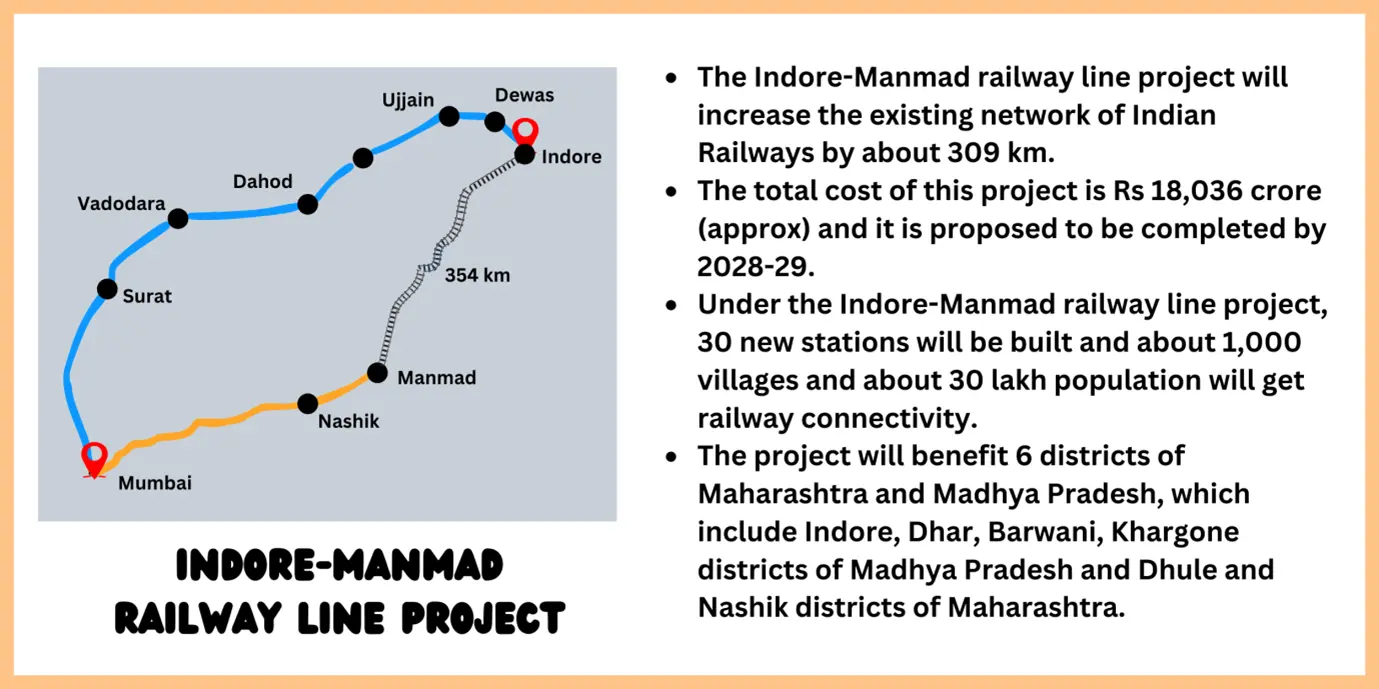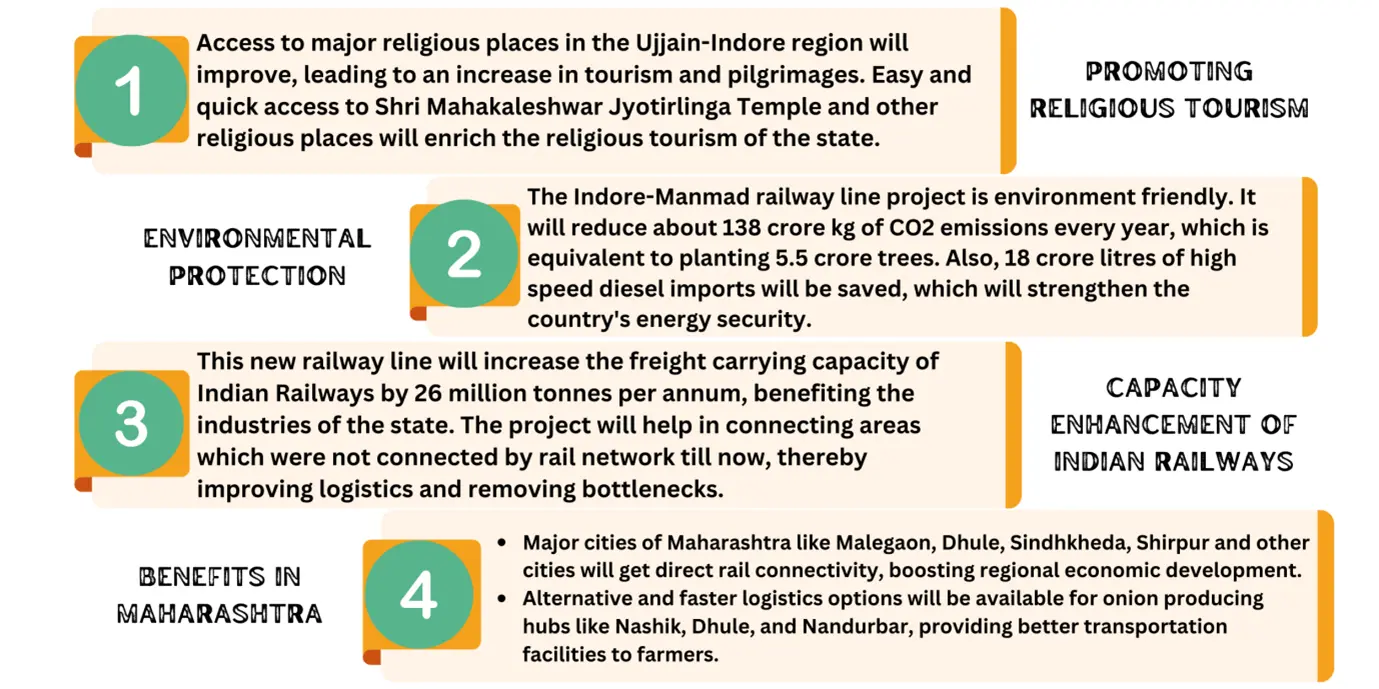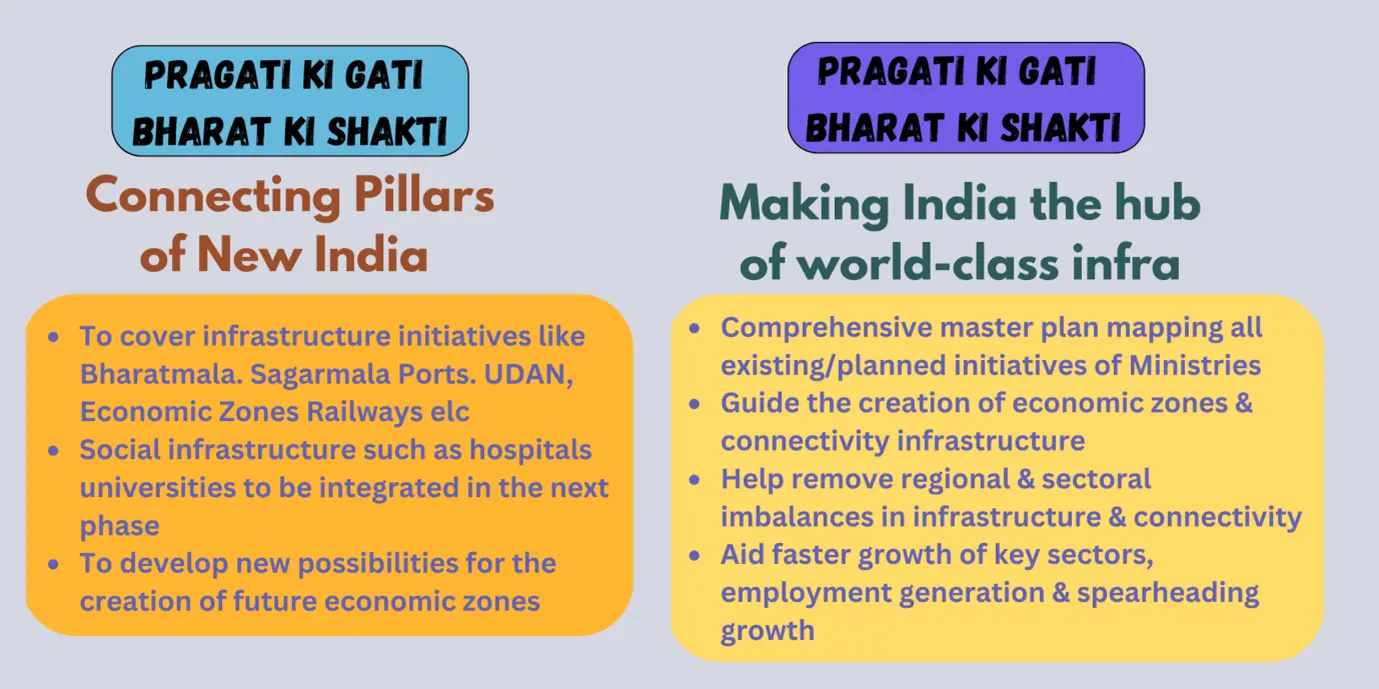The Cabinet Committee on Economic Affairs (CCEA) chaired by Prime Minister Shri Narendra Modi has approved the 309 km long Indore-Manmad railway
line project under the Ministry of Railways. Apart from connecting the business centres Mumbai and Indore by the shortest rail route, this
project will also connect those districts of Maharashtra and Madhya Pradesh which were not connected by rail till now.

Significance
- The Indore-Manmad railway line project will increase the existing network of Indian Railways by about 309 km.
- The total cost of this project is Rs 18,036 crore (approx.) and it is proposed to be completed by 2028-29.
- Under the Indore-Manmad railway line project, 30 new stations will be built and about 1,000 villages and about 30 lakh population will get railway connectivity.
- The project will benefit 6 districts of Maharashtra and Madhya Pradesh, which include Indore, Dhar, Barwani, Khargone districts of Madhya Pradesh and Dhule and Nashik districts of Maharashtra.
- The project is part of PM-Gati Shakti National Master Plan for Multi-Modal Connectivity, which is being implemented through integrated planning and will provide seamless connectivity for the movement of people, goods and services
Other Important Facts
- The project will promote tourism at various tourist/religious places in Ujjain-Indore region including Shri Mahakaleshwar Jyotirlinga Temple.
- The project will provide direct connectivity of Pithampur auto cluster (90 large units and 700 small and medium industries) to JNPA's Gateway Port and other state ports.
- The project will provide direct connectivity between millet producing districts of Madhya Pradesh and onion producing districts of Maharashtra.
- It will emerge as an essential route for transportation of commodities like agricultural products, fertilizers, containers, iron ore, steel, cement, POL etc.
- Railways is an environment friendly and energy efficient mode of transport, which plays a vital role in achieving climate goals and reducing the logistics cost of the country, this project will reduce oil imports by 18 crore litres and is estimated to reduce carbon dioxide emissions by 138 crore kg which is equivalent to planting 5.5 crore trees.
Key benefits of the Project:

Cabinet Committee on Economic Affairs:
Composition:
CCEA is headed by Prime minister and includes few ministry heads to handle different departments of CCEA. These members have an
important role regarding the formulation of Indian economic policies and decisions.
Functions and Responsibilities:
- Formulating and Implementing Policies: This one is involved in formulating and implementing major economic policies and strategies. It can be visualized to be as India’s economic master plan, and an architect of such a structure.
- Project Approvals: It approves big investment plans and projects (particularly those require huge cash commitment or huge implications in the body’s economy).
- Monitoring Implementation: It monitors the process of implementation modern large-scale economic policies and programmes. Vaguely as it may sound, it keeps things in check like a good supervisor is expected to do.
- Key Economic Issues: The CCEA gives guidance on vital issues on economic concern—consideration of inflation, trade, investment, and industrial policy. It is similar to the needle that points to the North when talking about the ship.
- Coordinating Across Ministries: To ensure that the country does not end up within an economic disaster, the CCEA ensures that the economic policies formulated are in harmony with all ministries as well as departments within the country. It is the conductor of the economic activity- the conductor of the economic play.
- Promoting Partnerships: It fosters and supports partnership between government and private entities/individuals and supports private sector in some of the most critical areas of the economy.
Approval Process
It is also important to note that the CCEA has the power of ratification of proposals and projects with budgetary values that can be huge. Here’s what typically falls under its purview:
- Schemes and Investment programs which had an investment of more than Rs. 1000 crores (USD 135 million).
- Proposals in investment that require FDI of more than USD 675 million or Rs. 5,000 crore in Indian context.
- Excessive and impulsive diversification leading to the other extreme, that is, disinvestment of government equity in public sector undertakings.
- Contracting with the private sector for the formation of joint venture or through subsidiaries.
For project proposals to be considered by CCEA ministries need to provide the financial and economic analysis. It is like being an attorney in a court and presenting well-digested arguments before the economic jury.
PM-Gati Shakti National Master Plan

What Is PM-Gati Shakti?
- Purpose: The first objective of PM-Gati Shakti is to compile all the ministries and departments related to infrastructural development such as Railways & Roadways on a common technological interface. That way, the planning and implementation of infrastructure projects are synchronised in an integrated manner.
- Connectivity: The Prime Minister’s Gati Shakti vision is to integrate various means of transportation to enable transportation of people, products, and services from one mode to another – Roads, Rails, Waterways, and Airways.
- Last Mile Connectivity: The last-mile connectivity aims to build transport infrastructure to enhance accessibility for people and firms to the required transportations.
- Reducing Travel Time: The successful planning and implementation of PM-Gati Shakti programme has a rationale of increasing the speed of the mobility means and improving the overall speed.
Key Features and Vision:
- Incorporating Existing Schemes: PM-Gati Shakti links present infrastructure programmes of different ministries and state governments. Some of them are Bharatmala (roads), Sagarmala (ports), Inland waterways, UDAN (unserved and under-served regional connectivity) among others.
- Economic Zones: It is a strategic framework that appertains to economic regions including textile weaving zones, pharmaceutical hubs, defines production zones, electronics parks, industrial growth corridors, fishing clusters and agricultural sectors. The intended objective is to spread the networking and increase the efficiency of the companies which are in India.
- Technology Leveraging: PM-Gati Shakti technologically leverages space application particularly through spatial tools with ISRO imagery enabled through BiSAG-N.
Challenges Addressed:
- Historical Lack of Coordination: Earlier, it was seen that a lot of departments were functioning in isolation and this resulted in a lag. For instance, after construction of a road other agencies may remove it to conduct other activities such as installing underground cables or gas pipeline. PM-Gati Shakti is designed to enhance integration to arrest such unconstructive endeavours.
- Streamlining Approvals: The plan was drawn with considerations on challenges such as extended time taken in approvals and several regulatory clearances.
- Holistic Planning: In this, there is no planning on different sectors in the segregation of different sectors but it is integrated. It helps in that projects are developed and implemented in a similar approach, and thus the improved results.
6 principles of PM-Gati Shakti
PM Gati Shakti National Master Plan for Multi-Modal Connectivity is based on six pillars which align it to be coherent and systematic.
- Comprehensiveness: it seeks to counter structure the organizational culture of silos. These are, the existing common portals of the Ministries include PM-Gati Shakti which consolidates all current and proposed efforts in every Ministry and department under an integrated portal. It would be like an open platform wherein everyone will see what is happening related to an infrastructure planning. This way of having the big picture increases efficacy in coordination and information sharing, and in critical assessment during planning and implementation phases.
- Prioritization: PM-Gati Shakti brings clarity. Various companies’ departments now cooperate and decide on the order of tasks in the trans-sectorial meetings. Prioritization ensures that resources are well deployed and the most effective projects visible.
- Optimization: however big a project one has in mind (or a new infrastructure idea), preparation is key. Optimization guarantees the availability of necessary infrastructure, such as transportation systems, sea-shores and other commercial structures before project commencement. PM-Gati Shakti makes sure that everything is in place including the ground-breaking.
- Holistic Planning: PM-Gati Shakti helps with the integrated planning. What is significant is that there are no blueprints that indicate that the projects for the different sectors must be done differently. It is as though one is directing a ballet where everyone knows the right steps to perform and in harmony with the rest. There is no fragmented approach and all sewers together to play an orchestra of infrastructure construction
- Economic Zones Integration: PM-Gati Shakti is present in multiple economic zones including; textile clusters, pharmaceutical clusters, defence corridors, electronics parks, industrial zones, fishing clusters, agricultural areas. Such are specialized zones, and the plan guarantees they will be easily communicated with other zones.
- Leveraging Technology: The Prime Minister, through ‘PM Gati Shakti’ is completely assimilating technology in its true sense. A spatial planning tool that includes reliable imagery from ISRO is proven to be helpful in this situation. Picture a chart and that can be zoomed in to show each and every road, rail and ports of a country.